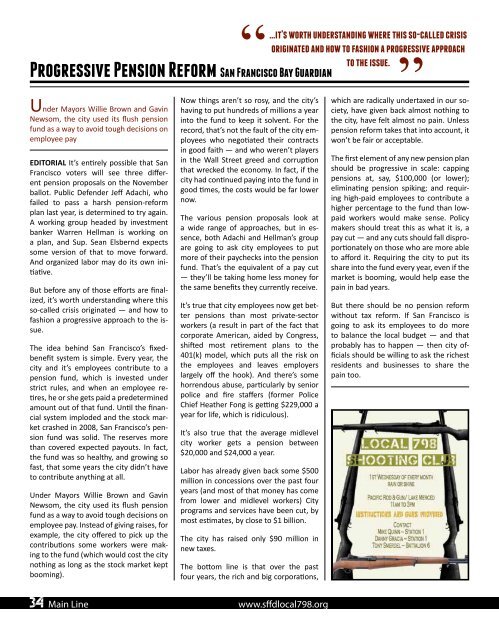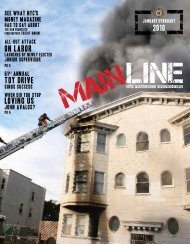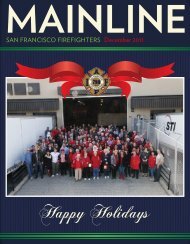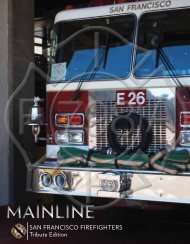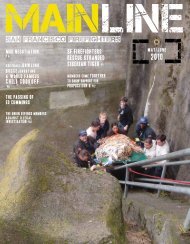Mainline - San Francisco Firefighters Local 798
Mainline - San Francisco Firefighters Local 798
Mainline - San Francisco Firefighters Local 798
You also want an ePaper? Increase the reach of your titles
YUMPU automatically turns print PDFs into web optimized ePapers that Google loves.
“<br />
Progressive Pension Reform <strong>San</strong> <strong>Francisco</strong> Bay Guardian<br />
“<br />
...it’s worth understanding where this so-called crisis<br />
originated and how to fashion a progressive approach<br />
to the issue.<br />
Under Mayors Willie Brown and Gavin<br />
Newsom, the city used its flush pension<br />
fund as a way to avoid tough decisions on<br />
employee pay<br />
EDITORIAL It’s entirely possible that <strong>San</strong><br />
<strong>Francisco</strong> voters will see three different<br />
pension proposals on the November<br />
ballot. Public Defender Jeff Adachi, who<br />
failed to pass a harsh pension-reform<br />
plan last year, is determined to try again.<br />
A working group headed by investment<br />
banker Warren Hellman is working on<br />
a plan, and Sup. Sean Elsbernd expects<br />
some version of that to move forward.<br />
And organized labor may do its own initiative.<br />
But before any of those efforts are finalized,<br />
it’s worth understanding where this<br />
so-called crisis originated — and how to<br />
fashion a progressive approach to the issue.<br />
The idea behind <strong>San</strong> <strong>Francisco</strong>’s fixedbenefit<br />
system is simple. Every year, the<br />
city and it’s employees contribute to a<br />
pension fund, which is invested under<br />
strict rules, and when an employee retires,<br />
he or she gets paid a predetermined<br />
amount out of that fund. Until the financial<br />
system imploded and the stock market<br />
crashed in 2008, <strong>San</strong> <strong>Francisco</strong>’s pension<br />
fund was solid. The reserves more<br />
than covered expected payouts. In fact,<br />
the fund was so healthy, and growing so<br />
fast, that some years the city didn’t have<br />
to contribute anything at all.<br />
Under Mayors Willie Brown and Gavin<br />
Newsom, the city used its flush pension<br />
fund as a way to avoid tough decisions on<br />
employee pay. Instead of giving raises, for<br />
example, the city offered to pick up the<br />
contributions some workers were making<br />
to the fund (which would cost the city<br />
nothing as long as the stock market kept<br />
booming).<br />
Now things aren’t so rosy, and the city’s<br />
having to put hundreds of millions a year<br />
into the fund to keep it solvent. For the<br />
record, that’s not the fault of the city employees<br />
who negotiated their contracts<br />
in good faith — and who weren’t players<br />
in the Wall Street greed and corruption<br />
that wrecked the economy. In fact, if the<br />
city had continued paying into the fund in<br />
good times, the costs would be far lower<br />
now.<br />
The various pension proposals look at<br />
a wide range of approaches, but in essence,<br />
both Adachi and Hellman’s group<br />
are going to ask city employees to put<br />
more of their paychecks into the pension<br />
fund. That’s the equivalent of a pay cut<br />
— they’ll be taking home less money for<br />
the same benefits they currently receive.<br />
It’s true that city employees now get better<br />
pensions than most private-sector<br />
workers (a result in part of the fact that<br />
corporate American, aided by Congress,<br />
shifted most retirement plans to the<br />
401(k) model, which puts all the risk on<br />
the employees and leaves employers<br />
largely off the hook). And there’s some<br />
horrendous abuse, particularly by senior<br />
police and fire staffers (former Police<br />
Chief Heather Fong is getting $229,000 a<br />
year for life, which is ridiculous).<br />
It’s also true that the average midlevel<br />
city worker gets a pension between<br />
$20,000 and $24,000 a year.<br />
Labor has already given back some $500<br />
million in concessions over the past four<br />
years (and most of that money has come<br />
from lower and midlevel workers) City<br />
programs and services have been cut, by<br />
most estimates, by close to $1 billion.<br />
The city has raised only $90 million in<br />
new taxes.<br />
The bottom line is that over the past<br />
four years, the rich and big corporations,<br />
which are radically undertaxed in our society,<br />
have given back almost nothing to<br />
the city, have felt almost no pain. Unless<br />
pension reform takes that into account, it<br />
won’t be fair or acceptable.<br />
The first element of any new pension plan<br />
should be progressive in scale: capping<br />
pensions at, say, $100,000 (or lower);<br />
eliminating pension spiking; and requiring<br />
high-paid employees to contribute a<br />
higher percentage to the fund than lowpaid<br />
workers would make sense. Policy<br />
makers should treat this as what it is, a<br />
pay cut — and any cuts should fall disproportionately<br />
on those who are more able<br />
to afford it. Requiring the city to put its<br />
share into the fund every year, even if the<br />
market is booming, would help ease the<br />
pain in bad years.<br />
But there should be no pension reform<br />
without tax reform. If <strong>San</strong> <strong>Francisco</strong> is<br />
going to ask its employees to do more<br />
to balance the local budget — and that<br />
probably has to happen — then city officials<br />
should be willing to ask the richest<br />
residents and businesses to share the<br />
pain too.<br />
34 Main Line www.sffdlocal<strong>798</strong>.org


